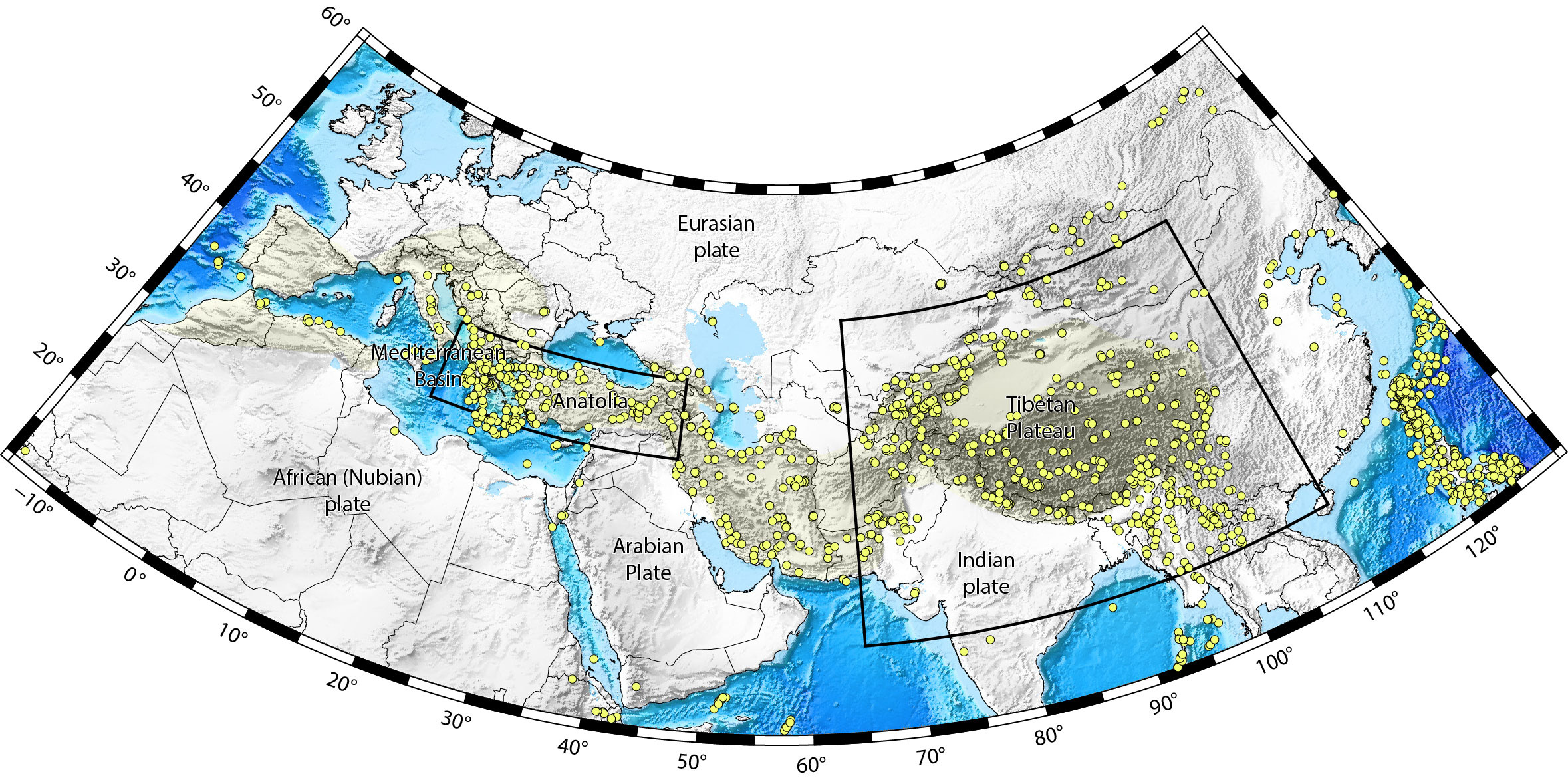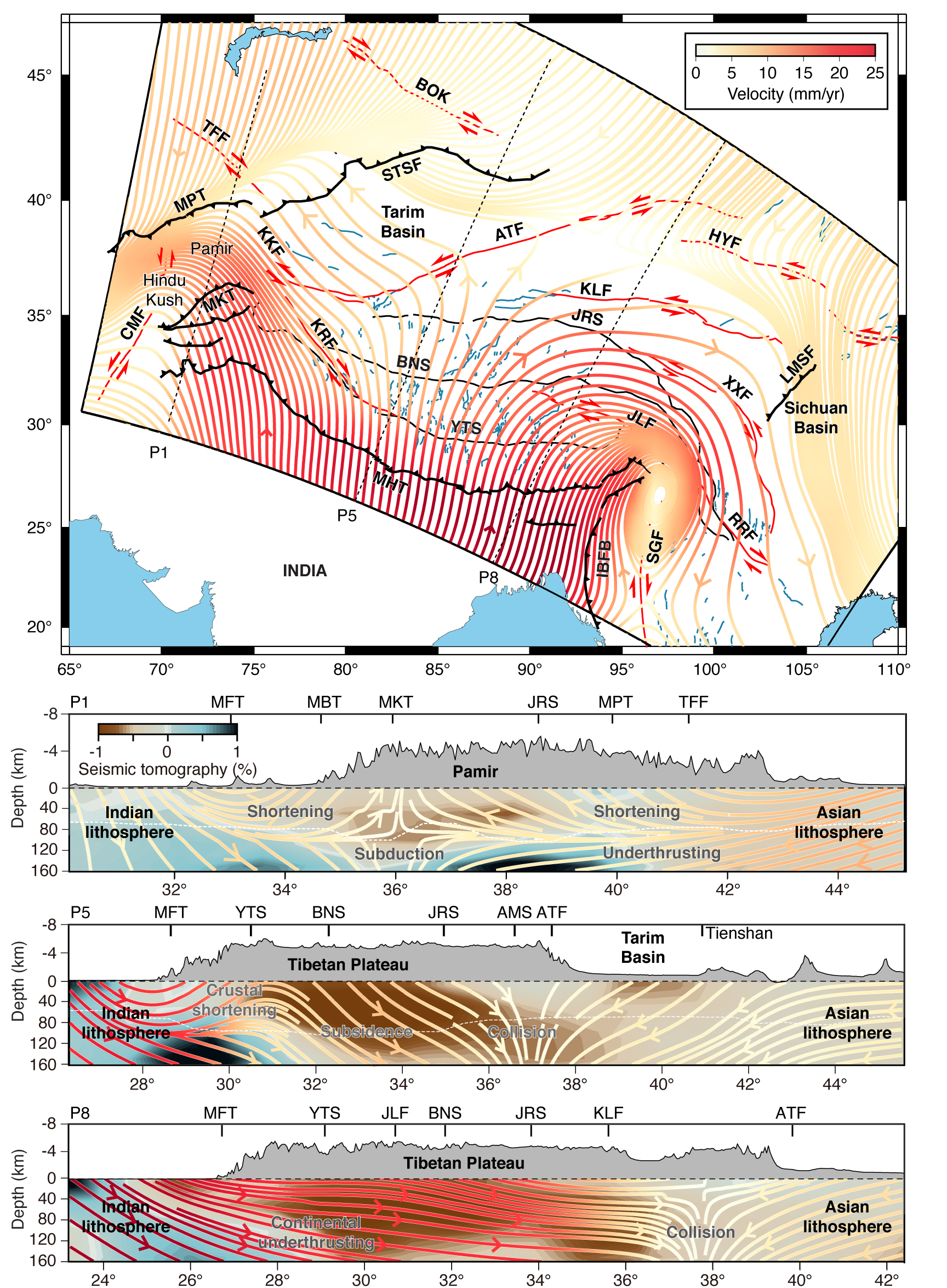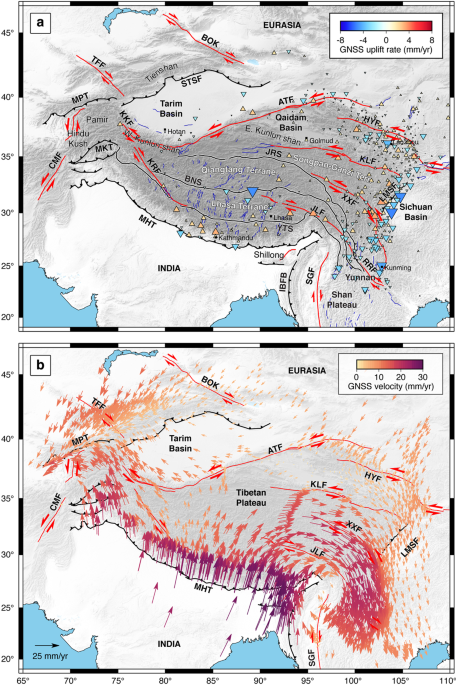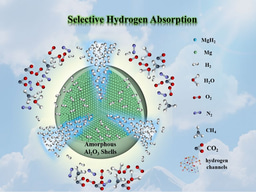Towards a three-dimensional kinematic model of the Alpine-Himalayan belt
Published in Earth & Environment
The Alpine-Himalayan belt forms an outstanding natural laboratory to study continental tectonics. The closure of the Tethys Sea in the Cretaceous formed a semi-continuous orogenic belt that connects the Atlas Mountains, European Alps, Mediterranean Ridge, Anatolian Faults, Zagros Mountains, Makran subduction zone, and, eventually, the immense Indian-Eurasian collision zone (Figure 1). Each of these tectonic terranes exhibits complex deformation, shaped by strength and density contrasts. The relative motion among microplates produces collision zones, subductions, and tectonic escape with complex interactions. The collision of the Indian subcontinent with Eurasia over about 60 million years has produced the Himalayan Ranges and the Tibetan Plateau. The relationships among tectonics, paleoclimate, and biology in these regions have been studied extensively. An overarching question is how plate tectonics operates in the continental interior, considering the weakness of the continental crust relative to the oceanic lithosphere. Plate tectonics in the oceanic lithosphere is shaped by volcanism at mid-ocean ridges, which produces ridge-transform systems and leaves behind fracture zones across abyssal plains, and opposite-facing subduction zones. The interior of oceanic plates is only occasionally disrupted by mantle plumes, large igneous provinces, and, more rarely, diffuse seismicity. In the continental interior, however, the rock cycle is still poorly understood. How are rocks recycled into the mantle? How is the motion of deforming continents accommodated at depth? What is the relationship between mantle flow and surface deformation?

Figure 1. Seismic activity in the Alpine-Himalayan Belt, a vast mountain range system that stretches at a distance of over 8,000 kilometers across Eurasia, from the Alps in Europe through the Mediterranean region, the Middle East, Central Asia, the Himalayas, finally terminating in Southeast Asia. Modeling of deformation in Anatolia (Barbot & Weiss, 2021) and the Tibetan Plateau (Wang & Barbot, 2023) is marked with black boxes.
Recent progress in geodetic monitoring and modeling provides new insights into these fundamental questions. First, the density and footprint of instrumented geodetic observatories across the Alpine-Himalayan belt have increased dramatically in recent years, providing continuous networks across much of Europe and much of the Tibetan Plateau, except for remaining observational gaps in Iran, Afghanistan, and Pakistan. Moreover, remote sensing with synthetic aperture radar, thanks to projects conducted at COMET (Lazecky, 2020; Ou et al., 2022), JPL (https://aria.jpl.nasa.gov/products/index.html), and ISTERRE (Daout et al., 2017), now offers additional continuous coverage. These data provide new constraints into tectonic processes along the Alpine-Himalayan belt. Second, recent progress in physical modeling of lithosphere dynamics (Barbot, 2018) affords a new capacity to incorporate faulting and distributed deformation in three-dimensional models of tectonic processes.
The earliest application of this method maps the distribution of mantle flow below the California margin (Barbot, 2020). Along the Greece, Aegean Sea, and Anatolia section of the Alpine-Himalayan belt, this approach disentangles the strain partition among subduction and slab rollback at the Hellenic Trench, transtension in the Aegean Sea, and tectonic escape in Anatolia (Barbot & Weiss, 2021). A recent study resolved even more complex deformation around the Tibetan Plateau (Wang & Barbot, 2023), which is shaped by collision against the Indian and Eurasian lithospheres at its northern and southern boundaries, internal deformation by rifting and strike-slip faulting, and extrusion of the Tibetan crust across the western and eastern syntaxes (Figure 2). Modeling of geodetic data allows us to identify the three-dimensional kinematics of the Indian-Eurasian diffuse collision, clarifying the extent and interplay between frontal collision, delamination rollback, and continental underthrusting.
Looking ahead, building a continuous kinematic model of the Alpine-Himalayan Belt may clarify the tectonic structures underlying the Alps, Apennines, and Dinarides in western Europe, and the Caucasus and Zagros mountains in the Middle East. Integration of synthetic aperture radar and global navigation satellite systems may essentially circumvent the instrumentation gap of the Middle East and finally illuminate the continuous three-dimensional kinematics of the Alpine-Himalayan Belt.

Figure 2. Three-dimensional kinematics of the Indian-Eurasian diffuse collision zone. In map view the streamlines of the velocity field are characterized by lateral extrusion centered on Central Tibet, where the east-west extension is accommodated by a dense network of rifts (blue traces). In accompanied with the North-South shortening, this tectonic escape is facilitated by major strike-slip faults (red traces) on its path, and extrudes from the west and east outlets, north of the Himalayan syntaxes. Cross-sectional view in the lower panels reveals the mechanisms of continental tectonics, with a direct collision of the Indian and Eurasian lithosphere below the Pamir and Hindu Kush, crustal shortening and delamination rollback in the western Himalayas, and continental underthrusting closer to the eastern syntaxis. The line color represents velocity amplitude and the underlying color map in the lower panels shows seismic velocity.
References:
Barbot, S. (2018). Deformation of a Half‐Space from Anelastic Strain Confined in a Tetrahedral Volume. Bull. Seism. Soc. Am., 108(5A), 2687. https://doi.org/10.1785/0120180058
Barbot, S, & Weiss, J. R. (2021). Connecting subduction, extension and shear localization across the Aegean Sea and Anatolia. Geophysical Journal International, 226(1), 422–445. https://doi.org/10.1093/gji/ggab078
Barbot, S. (2020). Mantle flow distribution beneath the California margin. Nature Communications, 11(1), 4456. https://doi.org/10.1038/s41467-020-18260-8
Daout, S., Doin, M.-P., Peltzer, G., Socquet, A., & Lasserre, C. (2017). Large-scale InSAR monitoring of permafrost freeze-thaw cycles on the Tibetan Plateau. Geophysical Research Letters, 44(2), 901–909. https://doi.org/https://doi.org/10.1002/2016GL070781
Lazecky, M. (2020). LiCSAR: An Automatic InSAR Tool for Measuring and Monitoring Tectonic and Volcanic Activity. https://doi.org/10.20944/preprints202005.0520.v1
Ou, Q., Daout, S., Weiss, J. R., Shen, L., Lazecký, M., Wright, T. J., & Parsons, B. E. (2022). Large-Scale Interseismic Strain Mapping of the NE Tibetan Plateau From Sentinel-1 Interferometry. Journal of Geophysical Research: Solid Earth, 127(6), e2022JB024176. https://doi.org/https://doi.org/10.1029/2022JB024176
Wang, L., & Barbot, S. (2023). Three-dimensional kinematics of the India–Eurasia collision. Communications Earth & Environment, 4(1), 164. https://doi.org/10.1038/s43247-023-00815-4
Follow the Topic
-
Communications Earth & Environment

An open access journal from Nature Portfolio that publishes high-quality research, reviews and commentary in the Earth, environmental and planetary sciences.
Related Collections
With Collections, you can get published faster and increase your visibility.
Geology of the Moon
Publishing Model: Hybrid
Deadline: Jan 31, 2026
Drought
Publishing Model: Hybrid
Deadline: Mar 31, 2026






Please sign in or register for FREE
If you are a registered user on Research Communities by Springer Nature, please sign in